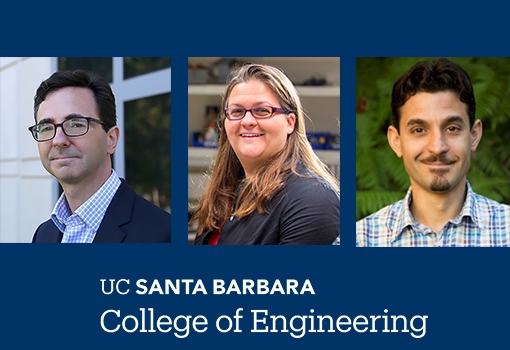Three professors from the College of Engineering, Megan Valentine, Michael Chabinyc, and Omar Saleh, are among the five UC Santa Barbara faculty who have been elected fellows of the American Physical Society (APS). This is the first time since 2015 that multiple UCSB faculty have been elected APS fellows in the same year. Less than one-half of one percent of the society’s 50,000 members receive the prestigious recognition from their peers each year.
Selected by the Division of Biological Physics, Valentine was cited for her “pioneering research in the development of microheology and the applications of biomechanics at multiple length scales to diverse biological systems.”
“The American Physical Society is the premier society for biological and biomaterial physics, and being selected as a fellow, includes me among the leaders in the field, which is truly inspiring,” said Valentine, a professor of mechanical engineering and associate director of the California NanoSystems Institute. “It is both an honor and a goal I set at the beginning of my career. The fact that I was elected one year after attaining full professorship at UCSB demonstrates the impact of my work. This honor further motivates me to continue pushing boundaries, pursuing interdisciplinary collaborations, and taking risks.”
Valentine’s research focuses on understanding how forces are generated and transmitted in living materials and how they control cellular outcomes. She also examines how to capture and mimic, in man-made materials, the extraordinary features of living systems, including the ability to respond, move, and heal. Her work to advance the understanding of fundamental biological processes could enable better disease diagnostics and treatments, and inspire the creation of high-performance materials used in coatings, packaging, and robotics.
Saleh, professor of materials and biomolecular science and engineering, was honored by the Division of Biological Physics for “outstanding contributions to single-molecule biophysics, including development of magnetic tweezer instrumentation and its use in elucidating electrostatic and self-avoidance contributions to biopolymer structure, as well as mechanics of motion of ring-shaped ATPases along DNA.”
“There is special significance for me to be elected as a fellow,” said Saleh. “ As a young graduate student in 1999, I attended the centennial APS meeting and was blown away by the range of ideas on display. It was that meeting that really confirmed for me that I should pursue a career in science. So, it is extra meaningful to now be honored by the same society that had such a profound effect on me.”
Saleh’s research group studies the physical principles governing the behavior of soft, biological molecules and materials. Biomolecules take part in a wide array of complex interactions and behaviors, so untangling them will lead to new insights into what it means to be alive, as well as generate ideas and opportunities for new applications.
Chabinyc, chair of the Materials Department, studies how to make electronic devices from polymers that conduct electricity. These materials can be printed from solvents, like an ink, to produce flexible transistors and solar cells. By using X-rays and electron microscopy to study how these polymers pack together at the nanoscale, Chabinyc develops new rules for structural design of these functional materials.
He was recognized by the Division of Polymer Physics and cited for “contributions to the understanding of relationships between structure and electronic properties of conjugated polymers, and the translation of these relationships to functional devices such as transistors and solar cells.”
“I am honored to be selected,” said Chabinyc, who was named a Materials Research Society fellow earlier this year. “I believe the selection of multiple faculty who study synthetic polymers and biopolymers recognizes the strength of UCSB in soft materials.”
“It is especially significant that all three of us are mid-career scientists,” added Saleh. “To me this is a sign of the incredible system UCSB had in place for mentoring and nurturing young faculty when we started. It’s a collaborative culture that remains in place today.”
UCSB physics professors Zvonimir Dogic and Harry Nelson were also elected fellows. Dogic, like Valentine, Chabinyc, and Saleh, specializes in soft materials. He was cited for “experiments on equilibrium self-assembled systems and active liquid crystals, and for the bottom-up engineering of biomimetic systems with life-like properties.” Nelson, nominated by the Division of Particles and Fields, was cited for “contributions to the experimental campaign to discover weakly interacting massive particles.”

Michael Chabinyc (left), Megan Valentine (center), and Omar Saleh (right) were elected fellows of the American Physical Society.
